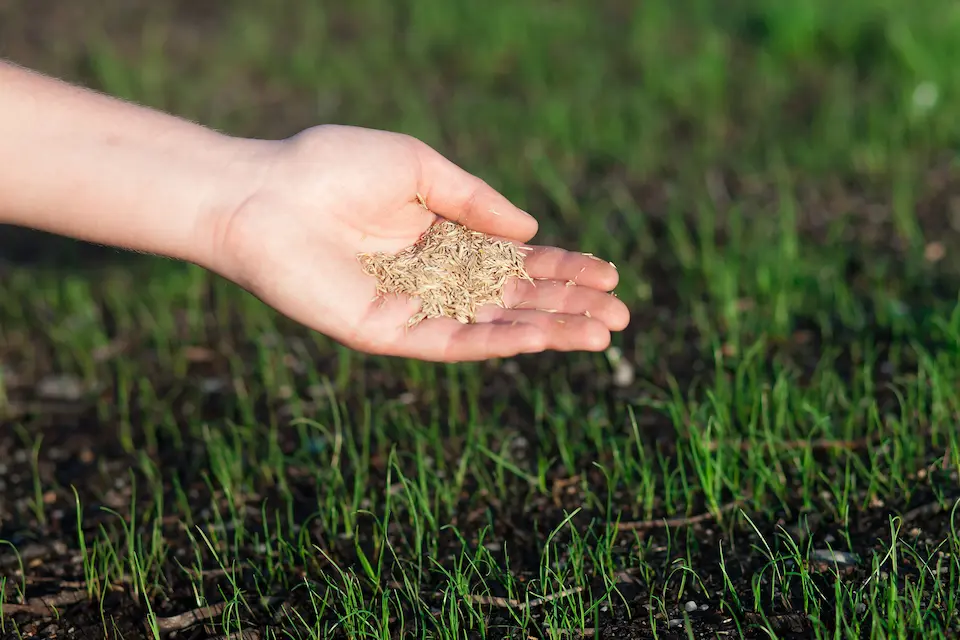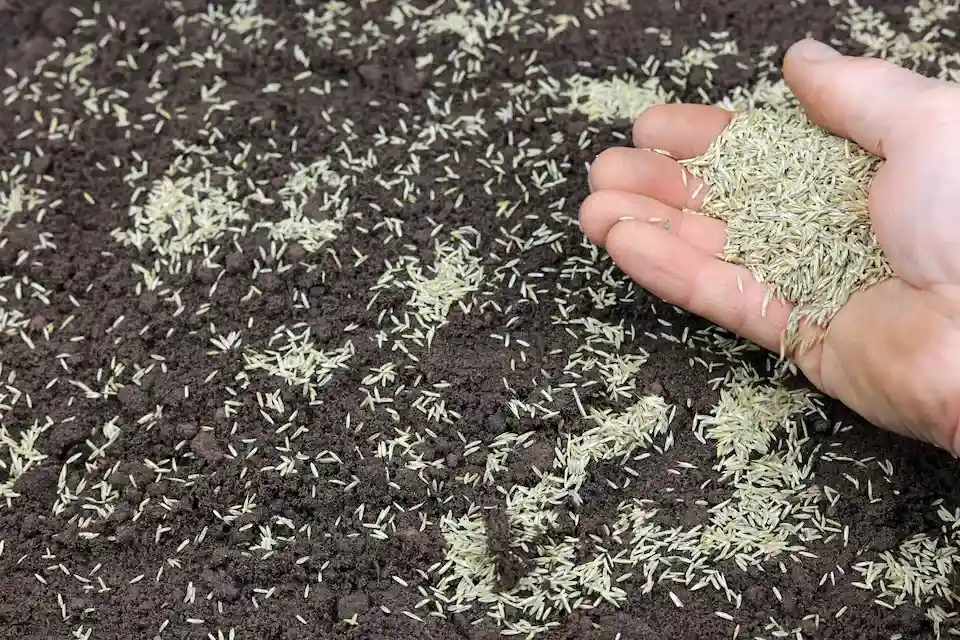
North Carolina, with its lush green landscapes and diverse climate, offers homeowners a unique canvas to create stunning outdoor spaces. Whether you’re a proud resident of Wake Forest or the surrounding areas or considering a move to Wake County, one aspect of local landscaping that often comes into play is the cultivation of a healthy, vibrant lawn. However, the burning question on many homeowners’ minds is this: When is it too late to plant grass seed?
FortSmith Landscaping’s experts in residential lawn care are sharing our secrets of timing in the planting of grass seeds, and the essential factors that should be considered to maintain a healthy, newly seeded lawn.
Considering Regional Climate to Sow Grass Seed
Nestled in the heart of North Carolina, Wake Forest boasts a climate that’s characterized by its four distinct seasons. Understanding the local climate is pivotal when it comes to planning your landscaping endeavors, especially for your lawn. Wake County experiences a humid subtropical climate, which means you’ll get to enjoy warm summers and relatively mild winters.
Temperature Patterns
Summers in Wake Forest are typically warm and humid, with temperatures often soaring into the upper 80s and lower 90s. These balmy conditions are perfect for outdoor activities and, of course, nurturing your lawn. Winters, on the other hand, bring cooler temperatures, with daytime highs averaging in the 40s and 50s. While it rarely experiences severe cold, occasional frost can occur during the winter months.
Precipitation
Wake Forest, Raleigh, and the surrounding areas of NC see a relatively steady amount of precipitation throughout the year. Summers are marked by periodic thunderstorms, which not only provide much-needed moisture but can also lead to quick growth spurts for your grass. Winters tend to be drier, with occasional rain and the possibility of light snowfall.

Different Grass Types Suitable for the Region
Choosing the right grass type is crucial for the health and appearance of your lawn in Wake Forest. Fortunately, this region offers a range of grass varieties that can thrive in its climate.
Warm-Season Grasses
- Bermuda Grass: Known for its heat tolerance and ability to withstand heavy foot traffic, Bermuda grass is a popular choice in Wake Forest. It thrives in the warm summers and can maintain its green color well into the fall.
- Zoysia Grass: Zoysia grass is another warm-season option that flourishes in the area. It’s known for its dense growth, making it an excellent choice for a lush, carpet-like lawn.
Cool-Season Grasses
- Tall Fescue: If you prefer a grass type that retains its green color throughout the year, even during the winter, tall fescue is a top pick. It can withstand the occasional cold snaps of Wake Forest winters.
- Kentucky Bluegrass: While less common in this region, Kentucky bluegrass can still thrive in well-maintained lawns. It’s prized for its fine texture and rich green color.
Selecting the appropriate grass type for your lawn is more than just a matter of personal preference. it’s a strategic decision based on the local climate and the air and soil temperatures. Choosing the right grass ensures that your lawn remains healthy and vibrant year-round.

Optimal Timing for Grass Seed Planting
The choice of when to plant grass seed depends on several factors, including the grass type, current lawn conditions, and personal preferences. Each season offers distinct advantages and challenges, so it’s essential to consider your specific circumstances when deciding on the optimal time to seed for a greener lawn.
Planting Grass Seed in Spring
Spring is often considered an ideal time to plant grass seeds in Wake Forest for several reasons. As temperatures begin to rise and the threat of frost diminishes, grasses awaken from their winter dormancy. This season typically spans from March through May and presents an excellent opportunity for lawn care activities.
Pros:
- Mild temperatures and increasing daylight hours promote rapid germination and growth.
- Moisture levels are typically higher in spring, reducing the need for extensive irrigation.
- Spring planting allows your lawn to establish itself before the scorching summer heat sets in.
Cons:
- Weeds are also active in spring and may compete with newly planted grass seed.
- The risk of late frosts in early spring can damage young grass seedlings.
- Timing is crucial; planting too early when the soil is still too cold may result in poor germination.
Summer Grass Seed Planting
North Carolina summers are characterized by warm and humid conditions, with temperatures often reaching their peak between June and August. During this period, grasses are in full growth mode, benefiting from the ample sunshine and occasional rain showers. While summer is a less common time to have grass seed planted, the season may be chosen for specific reasons.
Pros:
- Warm temperatures and consistent sunshine accelerate grass growth during this period.
- There’s less chance of late frosts that can harm young grass seedlings.
- You can enjoy your lush lawn during the peak of outdoor activities.
Cons:
- High summer temperatures require diligent watering to keep the soil consistently moist.
- Competition with established weeds can be a challenge.
- Without proper care, the summer heat can stress young grass seedlings, making them more susceptible to disease.
Early Fall and Late Fall Seeding
Fall, which spans from September to November, is a transition period in our local region of Wake Forest. Fall is often considered the best time to plant new grass seedlings for several reasons. The summer heat starts to wane, making it an ideal time for cool-season grasses to flourish. Fall is also marked by less rainfall compared to the summer months but with cooler temperatures, creating a conducive environment for grass establishment.
Pros:
- Cooler temperatures reduce stress on grass seedlings and minimize the need for frequent watering.
- Reduced weed competition allows new grass to be established more easily.
- Fall planting sets the stage for a strong, healthy lawn in the following spring.
Cons:
- The window for fall planting is relatively short, and timing is critical to ensure the grass is established before winter.
- Inconsistent rainfall in the fall may necessitate supplementary irrigation.
- Cool-season grass seed thrives in the fall, but warm-season varieties may struggle to establish.
Soil Preparation and Maintenance
Before embarking on any grass seed planting project, it’s essential to conduct a soil test. Soil testing serves as the foundation for a healthy and vibrant lawn.
Here’s why it’s crucial to your grass seeding schedule:
- Nutrient Assessment: Soil tests reveal the nutrient levels in your soil, including essential elements like nitrogen, phosphorus, and potassium. This information guides you in selecting the right fertilizers for your lawn.
- pH Balance: Soil pH affects nutrient availability to plants. Knowing your soil’s pH allows you to adjust it if necessary to create optimal conditions for grass growth.
- Customized Recommendations: Soil tests provide specific recommendations tailored to your lawn’s needs, ensuring you don’t waste time or resources on unnecessary treatments.
Soil Preparation Techniques
Proper soil preparation is a key step in ensuring the success of your grass seed planting project.
Follow these soil preparation techniques prior to adding new seedlings to your existing turf:
- Lawn Mowing: Begin by mowing your existing lawn at a low height. This helps remove excess vegetation and allows for better seed-to-soil contact during planting.
- Aeration: Aerating your soil improves water penetration and allows for better nutrient uptake by the grass’s root system. Use a lawn aerator to create small holes in the soil.
- Soil Amendments: Based on your soil test results, amend the soil with the appropriate materials. For instance, if your soil lacks essential nutrients, lawn fertilization is needed. Adjust soil pH as needed with lime or sulfur.
- Raking: After aerating and amending, rake the soil to create a smooth and level surface. Remove any debris or rocks that may hinder grass seed germination.
- Seed Distribution: Follow the recommended seeding rate for your chosen grass type, evenly distributing the seed over the prepared soil.
- Mulching: Applying a thin layer of straw or mulch over the seeded area helps retain moisture and protects the seeds from birds and wind.
- Watering: Gently water the seeded area, keeping the soil consistently moist but not waterlogged. Light daily watering is usually sufficient until the growing lawn is established.
The Role of Proper Maintenance Techniques
Maintaining a healthy lawn in Wake Forest requires ongoing efforts in order to result in a lush and thriving lawn that enhances the beauty of your property. By hiring professional landscaping and lawn care experts in Wake Forest, you can ensure that your new seeds flourish into growing grass that will be the envy of the neighborhood.
In addition to conducting soil temperature testing, FortSmith Landscaping offers the following lawn care services in Wake County:
Tips on Buying High-Quality Grass Seeds
Selecting high-quality grass seed is essential for the success of your lawn. Here are some tips to help you make the right choice:
- Read the Label: Examine the seed label for information on the grass variety, purity, and germination rate. Higher purity and germination rates indicate better quality.
- Choose Certified Seed: Look for grass seed that is certified by relevant authorities. Certification ensures that the seed meets specific quality and performance standards.
- Check for Weed Seeds: Avoid grass seed mixes with a high percentage of weed seeds. Quality seed should have minimal weed contamination.
- Consider Blend or Mixes: Depending on your lawn’s needs, you may opt for a seed blend or mixture that combines different grass varieties. These can provide better resilience and adaptability to various conditions.
- Store Properly: Once purchased, store your grass seed in a cool, dry place to maintain its viability until planting time.
Selecting the right grass seed varieties tailored to Wake Forest’s climate and your lawn care preferences is a vital step towards achieving a stunning and enduring lawn. By contracting a local landscaping company that focuses on the quality of grass seedlings, you’ll be on your way to creating a beautiful outdoor space that enhances the aesthetic and functional aspects of your property.
Contact Our Grass Seeding Experts in Wake Forest Today
Are you ready to transform your lawn into a lush, vibrant masterpiece that thrives in Wake Forest’s unique climate? At FortSmith Landscaping, our team of seasoned grass-seeding experts is here to guide you through the entire process, from selecting the perfect grass seed to expertly planting and maintaining your lawn. With our local knowledge and commitment to quality, you can trust us to create a landscape that stands out and adds value to your property.
Contact us today for a lawn consultation by calling [phone] or filling out the contact form below to get started.
